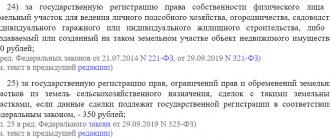On April 26, the Supreme Court of the Russian Federation published a review of judicial practice in cases of establishing an easement on a land plot. We will share the main findings.
You will find out which court to apply to establish, change the conditions or terminate the easement. We will explain what to do if the Unified State Register of Real Estate does not contain information about part of the land plot encumbered by an easement.
Formation of a land plot under a blocked building
What is an easement and how to get one
We have already told you that an easement is the right to limited use of someone else’s real estate (Article 1 N 122-FZ). This right is transferred to another person by right of encumbrance.
The right of encumbrance is otherwise called the right of limitation. Its definition is given in paragraph 1 of Article 1 of the Law on State Registration of Rights. The law or authorized bodies establish restrictions for the land owner in the exercise of ownership or other proprietary rights to a land plot.
Residents of neighboring houses may need an easement in order to lay communications through someone else’s land and use them. An easement may exist independently of the use of the land plot.
If you have received an easement, this does not mean that the plot has passed into your possession and its owners have lost the right to use it (Clause 2 of Article 274 of the Civil Code of the Russian Federation). The owners continue to use it, but for a specific purpose, which is established by contract or agreement.
To obtain an easement, you need to obtain the consent of the owners of the apartment complex. A simple majority of votes at the OCC will be sufficient. After this, an agreement or contract is concluded. This document is included in the technical documentation of the MKD.
Read more about what an easement is and how to get one
What factors influence the assessment?
To determine the amount of the proportionate fee for the easement, actual losses are taken into account:
- real damage - the difference between the market price of a land plot with and without a restriction;
- lost profit - the difference between the profit that the owner could have received from using the allotment before the establishment of the easement and after it;
- losses caused as a result of early termination of obligations to third parties.
The assessment results are influenced by the current situation on the real estate market in the region, the condition and purpose of the site, its location, transport accessibility, area, type and scope of restrictions imposed. The characteristics of the property matter. For example, if there is a shopping center or large warehouse complex on the site, the establishment of an easement may entail more serious losses for the owner than in the case of an empty territory.
Which court considers easement issues?
To accurately determine which court to contact to resolve issues of easement, clarify the subject composition of the parties to the dispute and the nature of the legal relationship. There are two options - a court of general jurisdiction or an arbitration court.
According to Parts 1 and 2 of Art. 27 of the Arbitration Procedure Code of the Russian Federation, arbitration courts consider:
- economic disputes;
- cases involving legal entities and individuals carrying out entrepreneurial activities
- activities without forming a legal entity and having the status of individual entrepreneurs;
- cases involving the Russian Federation, constituent entities of the Russian Federation, municipalities, government bodies, etc.
Courts of general jurisdiction deal with cases provided for in Parts 1 and 2 of Art. 22 Code of Civil Procedure of the Russian Federation. But economic disputes and cases dealt with by arbitration courts are not resolved.
An easement is requested in relation to real estate that can be used for business activities:
- if the parties to the dispute have the status of entrepreneurs,
- if the dispute is between individual entrepreneurs regarding land not used for business activities.
But this fact does not mean that the dispute is of an economic nature and should be considered by an arbitration court.
The Supreme Court cites the district court's ruling as an example. He terminated the proceedings on the claim for the establishment of an easement. The plaintiff had the status of an individual entrepreneur and asked to establish an easement in relation to the land. He needed the easement to provide access to his land plot and non-residential premises.
The district court found that the plaintiff was the owner of a commercial property. His interest is to ensure the passage of transport for the transport of goods. The dispute was of an economic nature and therefore had to be considered by an arbitration court.
But courts of general jurisdiction do not always have the authority to resolve such disputes. For example, a dispute over the cancellation of an easement can be considered by a court of general jurisdiction and an arbitration court. It all depends on which court established the easement.
Registration of a land plot into the common property of the MKD
List of documents
- A document confirming the right to dispose of a land plot.
- A cadastral passport of an object or an extract from the Unified State Register of Real Estate indicating the main technical characteristics of the object and the buildings, structures and structures located on it.
- A document indicating the encumbrance (if any).
- Data on the amount of taxes, on the book value of the land plot.
Easement assessment is a complex undertaking that requires highly qualified specialists.
It is impossible to carry out calculations independently in accordance with the regulations. Only a specialized organization licensed to carry out professional activities can carry out an assessment of the easement of a land plot. The appraisal department has many years of experience working with objects of various types and purposes. Deep professional knowledge and experience allow us to guarantee quality workmanship. The company's liability is insured. To order an assessment service, call us or leave a request on the website.
Types of land use restrictions
Legally, encumbrances on land plots are distinguished:
- Private easement. It is applied on the basis of a concluded and registered agreement or court decision when the interests of a certain person or organization are affected. Typically, such an encumbrance is of a compensated nature and the owner of the land has the right to demand a reasonable payment from citizens or legal entities in whose favor the encumbrance is registered. Except in cases where federal legislation is applied, obliging the application of a gratuitous restriction or when the owner himself voluntarily refused the payment.
- Public easement. Established subject to the availability of a regulatory document of a government body or municipal entity. It can be imposed on the territory of land through which public communications are carried out, for example, water supply, gas pipelines. Here, the land owner cannot count on monetary compensation in connection with the imposition of an encumbrance.
Easements also differ according to the period for which they are established, it happens:
- permanent, without setting a deadline;
- urgent, when a specific period during which it will be valid is determined, or the occurrence of an event upon the occurrence of which the servitude will be lifted. As a rule, it is imposed in the case of certain work related to the laying of communications. Then, as soon as the work is completed, the encumbrance ceases;
What costs are involved in terminating a limited right of use?
The consequences of terminating an easement may include certain costs, since this procedure is considered one of the most serious legally significant actions.
The main material investment of funds will be the payment of the state duty for registering the cancellation of the easement . Currently, this amount ranges from 500 to 2000 rubles, depending on who is the owner of the land plot - an individual or a legal entity.
If, when preparing an application and all necessary documents, you need to contact a lawyer or a notary, the services of such specialists are estimated at from 2,000 to 15,000 thousand rubles, depending on the cost of the established encumbrance (this calculation is determined by the notary price list).
Urban easement
It is established in relation to a site for the implementation of various urban needs on it (for example, for the construction of housing).
In this case, it is also established for the use of the “service” allotment in order to improve the dominant property. Depending on the specific methods of use, the following categories are distinguished:
Right to support
The conclusion is that the owner of the dominant plot has the opportunity to build a building on it, leaning on the wall of a neighboring building.
This right may include the following:
- the ability to rest your beam on the wall of someone else’s building;
- the ability to lean your own wall on the wall of someone else's building.
Right to use space
It was formed from the previous direction and often does not even stand out as a separate category.
It includes the following features:
- make a ledge that hangs over someone else's plot;
- Raise a roof, violating a neighbor's airspace.
Right to drains
It lies in the ability of the owner of the dominant plot to organize the flow of water from it through the service plot, namely:
- carry out sewage;
- drain excess water;
- ensure drainage of rainwater.
The right to windows (or rather, to the view from the windows)
Its essence is that the owner of a service plot is limited in his rights to erect buildings on it that would reduce the illumination of the house on the dominant plot or spoil its appearance.
The owner of the easement had the right:
- to ensure that the height of the neighboring building is within established limits;
- to ensure that there are no buildings on the neighbor’s land that impair the illumination of his plot;
- to ensure that no work is carried out on neighboring land that could obstruct the view from the building.
It is worth considering that this division of easements into urban and rural is in no way connected with the actual location of the site (within the city and in rural areas, respectively).
For example, a site located in a city may well be burdened with the right of passage through it established for third parties.
The actual purpose of the site and the purposes of its permitted use do not particularly influence the determination of a specific type of easement.
The fundamental criterion for such division is precisely the intended purpose of the easement itself.
Rural easement
It is established for land plots so that they can be used for agricultural purposes and for landscaping, regardless of their actual location.
It is worth noting that such an easement is one of the most ancient in Roman law.
It is installed on one property (servant) to improve another property (dominant). Due to the many different types of possible uses, it can also be divided into several categories:
Road
Includes the following rights:
- walk through the site;
- ride through it on horseback;
- drive through it on a cart with luggage.
Water
Provide the owner of the easement with the opportunity to:
- use water from the encumbered plot for the purpose of irrigating another plot;
- conduct water through it for the same purpose;
- draw water on it;
- drive cattle to water through this area or onto it.
Others
Covers the following rights for its owner:
- cook lime on someone else's property;
- extract sand from it;
- extract clay;
- store various fruits (berries, vegetables, fruits);
- export stone and ore;
- herd livestock;
- collect vines from someone else's land plot, etc.
It is obvious that some of the rights listed above are somewhat outdated and are unlikely to be in demand in modern conditions.
However, some purposes of rural easements remain relevant to this day.








